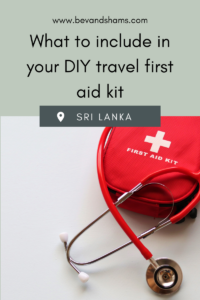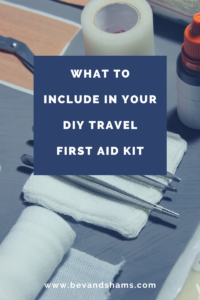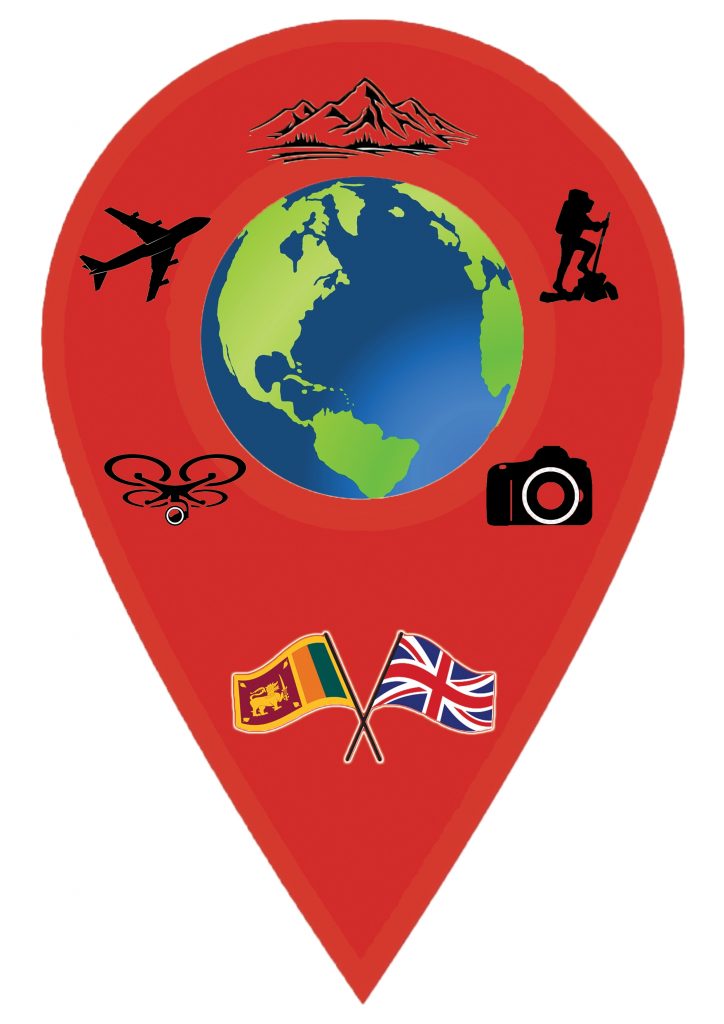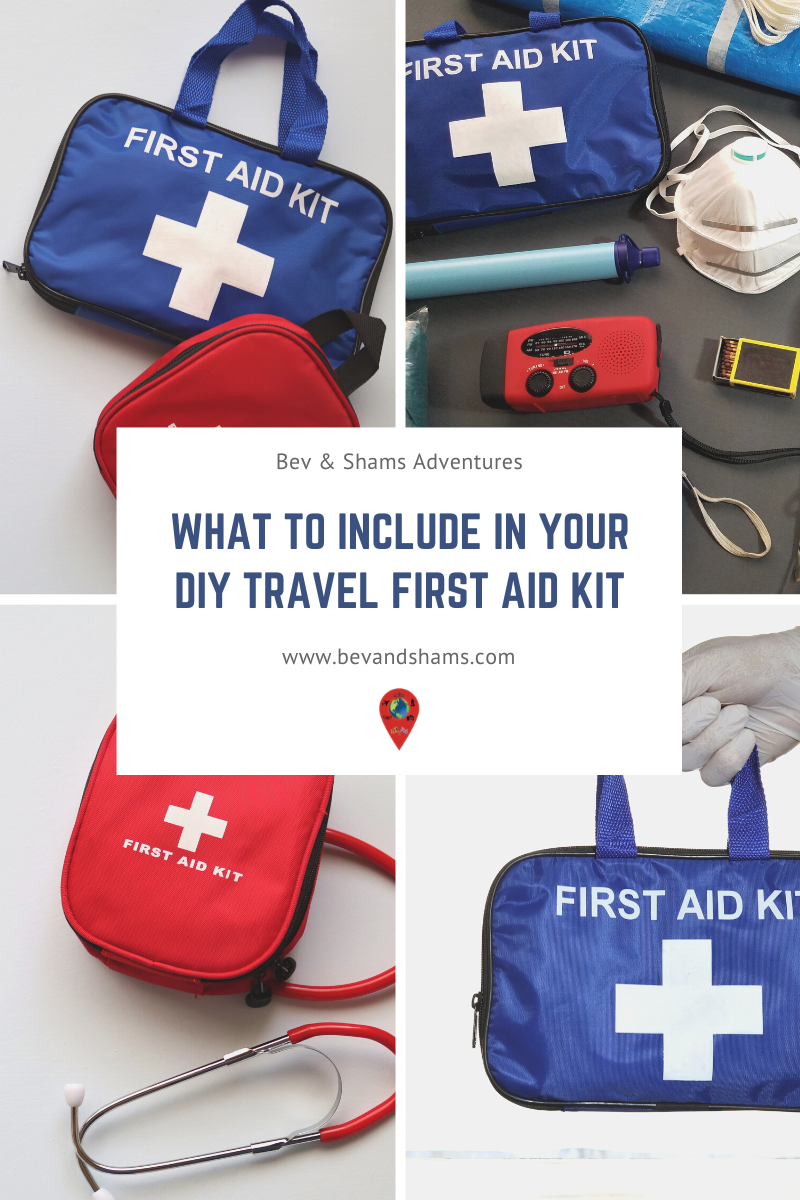What to include in your DIY travel first aid kit
One thing that most travelers do not want to happen when out on the road, is to sustain a minor injury or illness. But unfortunately, this does happen. This is why packing a DIY travel first aid kit is a must.
By packing everything we mention in this list, you will be able to self-medicate and be back on the road in no time.
We have both been unwell at one time or another when travelling in Sri Lanka. Shams once fell ill on a trip in Sigiriya and I became unwell on a return flight home from Sri Lanka. The one thing we learnt from this experience, was the importance of a travel first aid kit.
With our essential first aid kit, we were able to self-medicate and get back out travelling in no time.
We now, never leave home without it.
This is what we pack and we recommend that you copy this list for your own DIY travel first aid kit.
There may be affiliate links within this article, using these links will not cost you anything extra, but we may earn a small commission. Thank you for your support.
Table of Contents
What to include in your DIY travel first aid kit?
Whether you’re travelling solo, on a gap year, or with your family, here is what to include in a travel first aid kit.
Before you travel
Around 4-6 weeks before your travel dates, make an appointment with your local pharmacy or GP to check if you require any vaccinations.
Some countries may require certain vaccinations before entry and it could prevent serious illness, such as malaria, hepatitis etc. There’s an age old saying “prevention is better than cure”. Which is true in this case.
DIY first aid kit or pre made first aid kit?
For simplicity and ease, you could buy a first aid kit from your local shop. They are easy to come by and inexpensive.
The first aid kits you purchase from your local store, will come with everything you need to bandage you up.
However, we have also included a few additional things that you might not find in a pre-made first aid kit. Don’t worry, just purchase any essential items you may wish to also include.
Alternatively, if you would prefer to create your own, to personalise it, in accordance with your needs, then this is perfect for you.
While this is everything we carry, it is also suitable as a family travel first aid kit, for solo travelers, or couples. This is a case of one size fits all!
How to make a travel first aid kit
As experienced travelers, this is what we have packed in our mini travel first aid kit.
Plasters
The most common minor injuries a traveler will experience is cuts or scratches. Pack plasters to cover the wound to prevent infection.
Include a variety of sizes, depending on where and how large the wound is
Bandages and strain wrap
Help speed the recovery of a sprain or strain with a bandage or strain wrap.
Antiseptic wipes and antibacterial cream or wash
Antiseptic wipes or washes are great to wash a scratch or a cut, before applying the cream and then a plaster.
By washing the wound regularly, then applying the cream and replacing with a fresh plaster, will help to prevent infections.
Insect repellent and cream
It isn’t just tropical climbs that experience pesky insects that bite.
So, packing insect repellant into your small travel first aid kit is a must.
We use Jungle Formula mosquito repellent and it is perfect. Its small and easy to pack. And it stops us from getting bitten.
We have used it in Sri Lanka so many times and we barely find any bites, if any at all.
We have tried so many other brands, including mosquito plugs and spray. None of them seem to work and we still got bitten, but Jungle Formula changed that.
Insect bites can be so uncomfortable, especially the itching. Packing cream to help with the symptoms after being bitten will help. Although if you have applied the Jungle Formula insect roll on, it is unlikely you’ll need the cream.
Medication
Do you take medication for an ongoing medical condition? Don’t forget to pack some spare in your travel first aid kit. You never know when you might need them.
Also include over the counter medication such as painkillers, nausea and vomiting medication, diarrhea antidote, etc.
You never know when you might feel unwell and it could happen. One-year Shams suffered severe vomiting in Sri Lanka, she took some anti sickness tablets to stop the sickness and a rehydration sachet with water and within 24 hours, she was far better. I did the same when I fell unwell with diarrhea on the flight home from Sri Lanka a different time. I rehydrated myself and soon felt better for it.
As we say, you never know when you might become unwell, so being prepared and ready for any eventuality is always recommended.
We pack paracetamol and ibroprofen for headaches, high temperature and aches and pains. An anti-sickness medication, to prevent vomiting and Dioralyte, to rehydrate us if we suffer from bouts of diarrhea.
You’ll have different brands in your own country, or country you are travelling through.
Tip: It is recommended to retain the packaging and instructions with the medication, regardless of it being prescribed or over the counter. Also make sure the box or container is clearly labeled. Not only is this for the purpose of identifying the medication, but port officials may wish to confirm its content, especially when drugs are concerned.
Also note, that some countries may legalise certain substances found inside prescribed and over the counter medication, you may wish to check with the relevant authorities to ensure it is safe to cross the borders with it. We don’t want you to be arrested, for carrying illegal substances, when it might be legal in your home country. This has happened before and tourist have been jailed as a result.
Hand sanitiser
A few years ago, very few people would carry hand sanitiser with them, let alone pack it into their compact travel first aid kit. But since the outbreak of Covid, this is so important to include.
Most companies claim their hand sanitisers kill 99.9% of germs and bacteria. Well, you’ll want to protect yourself and your family.
So to help protect you and your family from Covid, or to help prevent the spread of germs, definitely pack a small hand sanitiser. You could also follow these few simple tips on travelling safely, to prevent the spread of germs.
Sun protection
This may not be required on every trip, but we have included it none the less. Why?
Regardless of the weather conditions, you could pack a small sun cream or spray, to protect you from the rays even on a cloudy day.
If it is always packed, you won’t forget it, when you do travel to hot sunny destinations.
When exposed to sun light, apply the cream or spray regularly, to prevent sun burn. I have had personal experience of sun burn, since I am fair haired and fair skinned. And I can tell you, it really isn’t pleasant.
In the event of sun burn, put cooling after sun cream on. It should sooth the pain and discomfort and aid with recovery.
Blister plasters
Walking a lot, either from pounding the city streets or going on a hike, can cause the shoe to rub the foot. This then causes blisters, which are very uncomfortable and can be painful.
Blister plasters will not only treat the affected area, but can make it somewhat comfortable.
To help prevent blisters, wear appropriate socks and comfortable shoes. If you have purchased new shoes, wear them in a bit before packing them for your holiday. The worst thing that could happen, is your new shoes rub and cause painful blisters.
Blister plasters can come in different shapes and sizes.
Keeping your travel first aid kit in order
Now you have your survival travel first aid kit, that will keep you well and on the road.
But you must regularly check the supplies and its expiry date. The worst thing that could happen when you need to use the first aid kit, is you don’t have enough supplies, or the medication has expired.
How to store your travel first aid kit
A travel first aid kit, that has been purchased from a store, will have most of the above included and you’ll get a small bag to store all the essentials in it.
If you are creating a DIY travel first aid kit, then you will need to source a bag to store everything you need in it.
For convenience and ease, we use a small clear bag, that we have picked up at airport security. Simply because it makes life easy when proceeding through airport security. We know that any liquids will be within the 100ml limit for travelling through an airport and if it needs to be examined by port officials, at a glance they can see its contents.
It is your preference on how you wish to store your first aid kit and its contents.
Conclusion
Our recommended DIY travel first aid kit, is so versatile, you can take things out that you may not need, or add anything additional, depending on the destination and activities you intend to do.
If you do exclude certain items from your first aid kit, such as sun cream and insect repellent for winter holidays, then put them back on your return home.
Our advice would be to leave it there, as you don’t want to forget something, you never know when you might need it.
It’s possible that you may not need to use anything from your first aid kit, but least you have it packed for when the unlikely event does happen.
So, whether it’s a staycation or international travel, travelling with family or solo, never leave home without your DIY travel first aid kit.
What have you got packed in your travel first aid kit? Is there anything you pack that we haven’t included? Let us know, by leaving a comment below.
Disclaimer: We would like to stress! We are not medically trained to deal with any serious illnesses or injuries. However, we do have a basic understanding of how to treat ourselves should we encounter a minor illness or injury that doesn’t require medical treatment by a qualified practitioner. This advice has been provided on the same basis, to assist you and your family. Furthermore, we have never encountered issues at customs, or by officials about the medication we have taken into a country. This does not mean that certain countries you visit will follow the same. We have heard in the media that some people have been imprisoned for taking over the counter remedies from their home country to another country that legalise that drug. Always check before you travel, to ensure all medication will not cause you problems when gaining entry to a country.
Continue your travel planning, with these useful posts:
- What to pack in your beach bag
- What to pack in your cabin bag
- Best travel backpacks for 2024 to purchase
- Best travel podcasts to listen to in 2024
- What to pack for a day hike
- Inspirational travel quotes
- How to stay fit while travelling
- How to travel on a budget
- What to pack for a weekend trip
- How to survive a long layover




